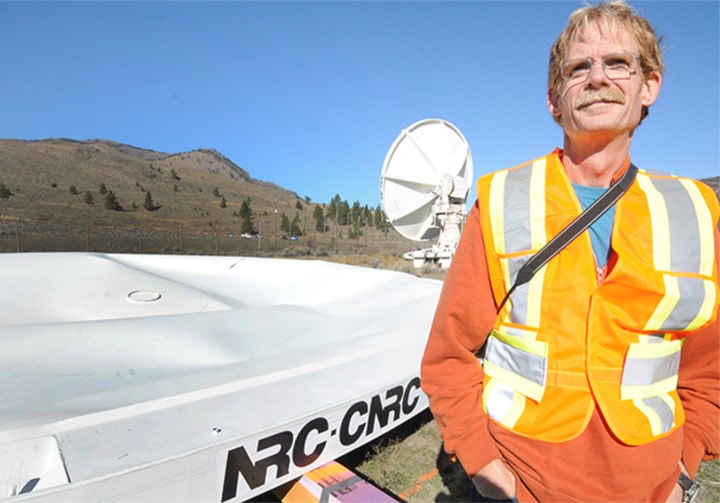An errant gust of wind is blamed for the in-flight damage to a 195-square-metre radio telescope reflector being airlifted into place at the Dominion Radio Astrophysical Observatory (DRAO) Thursday morning.
As the Kamov twin-rotor helicopter long-lining the structure from nearby Okanagan Falls approached the drop-off point, the convex reflector suddenly went vertical.
Several pieces of the dish could be seen falling before the VIH helicopter pilot was able to regain control.
Once it was on the ground, scientists and technical staff from the observatory quickly gathered around the large sphere to assess the damage which included several large cracks and buckling of the thin, metallised carbon-fibre surface
The reflector was built in a large facility in the industrial sector of Okanagan Falls and the total estimated cost, including moving it to the field where the pedestal it will be placed on is located, is about $300,000.
“The dishes are very thin (five millimetres) and so what happened when the helicopter slowed it looks like one of the lines went a little slack and it got up in a different attitude, the wind caught it a bit and when it came down again that inertia popped the dish and it lost its shape,” said project manager Dave Hovey of the DRAO shortly after the incident.
“What we were doing has never been done before and sometimes you have great successes and sometimes you have little glitches.
“This was a dramatic glitch but a glitch none the less.
“I’m not actually discouraged or anything, we’re just going to get up and dust ourselves off and go at it again.
“This is just a misstep and we’re going to recalibrate and we’ll be back.”
The reflector is a key part of a dish prototype concept for the Square Kilometre Array (SKA), described as one of the largest and most ambitious scientific projects in history.
It is the third in a series of National Research Council designs.
When the SKA is eventually built in Africa and Australia, scientists hope it will provide information about the formation of galaxies, how dark energy is accelerating expansion of the universe and life on other planets.
According to Hovey there was consideration given to using a truck to transport the dish but the logistics favoured the aerial route.
“Aerodynamic properties are very difficult to simulate and calculate but now we’ll know what we have to do,” he said.
“We budget for, back-to-the-drawing-board and (in) four months we’ll be back here.
“This scenario was one of those freak chances.”
Although it will take only about four months to construct another reflector, Hovey is concerned about the delay.
“We are in a bit of a foot race with the other countries,” he said. “We were ahead but now we’re even or behind.”
China and South Africa are working on similar prototypes.
Someone else who was disappointed with the incident was DRAO director Sean Dougherty although he too was optimistic about the future of the project.
“This morning didn’t work out ideally and it’s clearly a setback but we can repair the dish and put it on the pedestal,” said Dougherty.
“We’ll learn a lot of engineering properties of this design and at the same time we’ll probably build a second one and there may even be things that we learn about this prototype here that we can incorporate into the second.
“We can take advantage of this and come out ahead I believe.”
